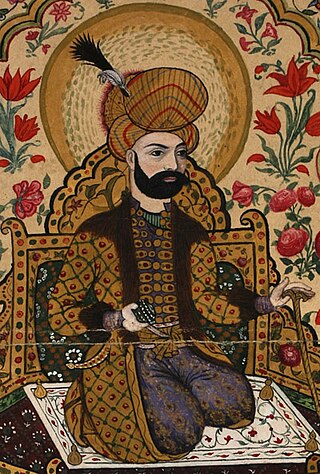Related Research Articles

Ismail I was the founder and first shah of Safavid Iran, ruling from 1501 until his death in 1524. His reign is often considered the beginning of modern Iranian history, as well as one of the gunpowder empires. The rule of Ismail I is one of the most vital in the history of Iran. Before his accession in 1501, Iran, since its conquest by the Arabs eight-and-a-half centuries earlier, had not existed as a unified country under native Iranian rule. Although many Iranian dynasties rose to power amidst this whole period, it was only under the Buyids that a vast part of Iran properly returned to Iranian rule (945–1055).

Khalilullah I, also known as Sultan-Khalil (سلطان-خلیل), was the Shirvanshah from 1418 to 1465. He was the son and successor of Ibrahim I. He was succeeded by his son Farrukh Yasar.

Farrukh Yasar was the last independent Shirvanshah of Shirvan (1465–1500). In 1500, the first Safavid ruler, Ismail I, decisively defeated and killed Farrukh Yasar during his conquest of the area. Descendants of Farrukh Yasar continued to rule Shirvan under Safavid suzerainty, until 1538, when Ismail's son and successor Tahmasp I appointed its first Safavid governor, and made it a fully functioning Safavid province.

David II also known as Imām Qulī Khān, of the Bagrationi dynasty, was a king of Kakheti in eastern Georgia from 1709 to 1722. Although a Muslim and a loyal vassal of the Safavid dynasty of Iran, he failed to ensure his kingdom's security and most of his reign was marked by razzias - incessant inroads by the Dagestani mountainous clansmen.

The Shirvanshahs were the rulers of Shirvan from 861 to 1538. The first ruling line were the Yazidids, an originally Arab and later Persianized dynasty, who became known as the Kasranids. The second ruling line were the Darbandi, distant relatives of the Yazidids/Kasranids.
The Yazidids or Mazyadids or Shaybanids, were an Arab family what came to rule over the region of Shirvan in the mid 9th century. Starting from Haytham ibn Khalid's assumption of the ancient Iranian title of Shirvanshah in 861, they practically broke free of Abbasid control and was therefore out of scope for most chroniclers of the Caliphate.

Shaykh Haydar or Sheikh Haydar was the successor of his father as leader of the Safavid order from 1460 to 1488. Haydar maintained the policies and political ambitions initiated by his father. Under Sheikh Haydar, the order became crystallized as a political movement with an increasingly extremist heterodox Twelver Shi'i coloring and Haydar was viewed as a divine figure by his followers. Shaykh Haydar was responsible for instructing his followers to adopt the scarlet headgear of 12 gores commemorating The Twelve Imams, which led to them being designated by the Turkish term Qizilbash "Red Head".
Gazikumukh Khanate was a Lak state that was established in present-day Dagestan after the disintegration of Gazikumukh Shamkhalate in 1642. Its peoples included various Lezgin tribes and Avars.

The Shirvan province was a province founded by the Safavid Empire on the territory of modern Azerbaijan and Russia (Dagestan) between 1501 and 1736 with its capital in the town of Shamakhi.

Yazid ibn Ahmad or Yazid II was the tenth Shirvanshah.
Afridun II was a Shah of Shirvan. He may have ruled during a time in Shirvanshah history that scholarship has referred to "a period of total confusion", due to the lack of written records and contradictory numismatic evidence. He was a son of Shirvanshah Manuchihr III. He had had three brothers, Akhsitan I, Farrukhzad I, and Shahanshah. He might not have even ruled. He left no numismatic evidence but known from his son Fariburz II's coins.
Shahrukh was the last Shirvanshah, governing Shirvan under Safavid suzerainty from 1535 to 1538. After persistent disloyalty, the Safavid shah (king) Tahmasp I expelled him, and made Shirvan a full administrative subunit of Safavid Iran. Subsequently, he appointed his brother Alqas Mirza as its governor.
Burhan Ali was a self-declared Shah of Shirvan. He claimed to be son of Khalilullah II.
Mehrab Mirza was the self-declared Shah of Shirvan after the death of Burhan Ali.
Gurban was the self-declared Shah of Shirvan after the downfall of Mehrab of Shirvan.
Qasem Mirza was the self-declared Shah of Shirvan after the death of Gurban Ali.
Kavus Mirza was the self-declared Shah of Shirvan in exile after the downfall of Qasem Mirza.
House of Derbent or Darbandids was a younger branch of Shirvanshahs that succeeded Kasranids.
Gokcheh Sultan Ziyadoghlu Qajar, better known as Shahverdi Sultan, was a Safavid military leader of Turkoman origin who was part of the Ziyadoghlu branch of the Qajars, who served as the governor of Karabakh and Ganja during the reign of king Tahmasp I.
The High Middle Ages, or Classic Feudalism Period in what constitutes the present-day Republic of Azerbaijan, lasted from around the 11th century to the 15th century AD. The High Middle Ages were preceded by the Early Middle Ages and were followed by the Late Middle Ages, which ended around the 15thcentury AD. Key historical trends of the High Middle Ages include the incorporation of the territories that constitute present-day Azerbaijan into the Seljuk Empire, the establishment of the Eldiguzids, the Mongol invasions and the rule of the Ilkhanate, the invasions of Timur and the establishment of the Turkoman Kara Koyunlu and Aq Qoyunlu tribal confederations.
References
- ↑ Sara Ashurbayli. History of Shirvanshahs. p.249